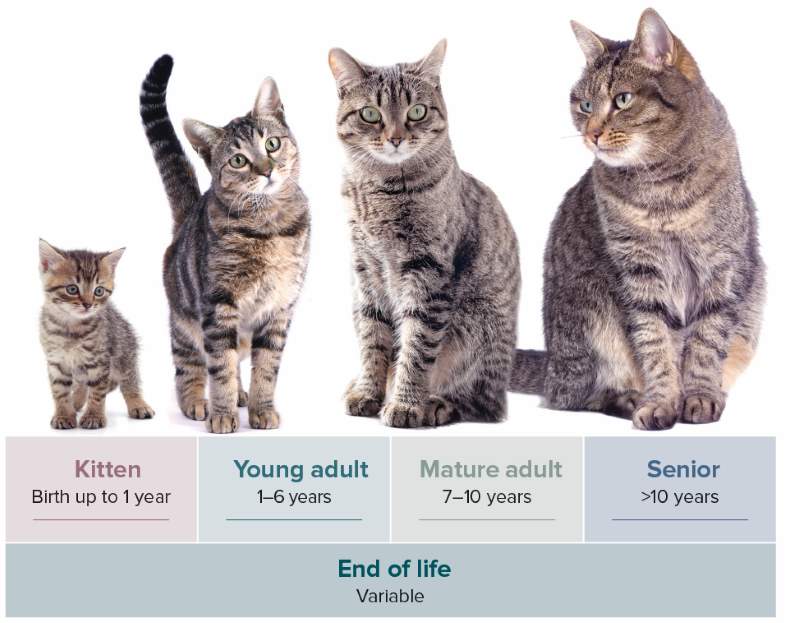Feline Life Stage Definitions
Life Stage Definitions and Relevant Clinical Perspectives
The Task Force has designated four age-related life stages (Table 1): the kitten stage, from birth up to 1 year; young adult, from 1 year through 6 years; mature adult, from 7 to 10 years; and senior, aged over 10 years. The fifth, end-of-life stage can occur at any age. These guidelines focus on the life stages of kitten through to senior. These age designations help to focus attention on the physical and behavioral changes, as well as the evolving medical needs, that occur at different stages of feline life. Examples include detection of congenital defects in kittens, obesity prevention in the young adult cat, and increased vigilance for early detection of renal disease in mature adult and senior cats. It must be recognized, however, that any age groupings are inevitably arbitrary demarcations along a spectrum and not absolutes.
Table 1
Feline Life Stages
© Voren1/iStock, spxChrome/E+, AaronAmat/iStock, AngiePhotos/iStock via Getty Images Plus
Although ages have been used to identify life stages, it is recognized that there may be significant variation among individual cats. For example, some senior cats aged 10 years and older may remain in excellent physical condition and would be best treated as a mature adult at the veterinarian’s discretion. The guidelines are intended to be a starting point from which individualized care recommendations can be developed.
Discussion Items for All Life Stages
The Task Force recommends a minimum of annual examinations for all cats, with increasing frequency as appropriate for their individual needs.6 Senior cats should be seen at least every 6 months and more frequently for those with chronic conditions. More information can be found in the AAFP Senior Care Guidelines.12 Seeing patients and clients at least annually provides an excellent opportunity for client education. Table 2 lists a number of discussion items relevant to all life stages. Some topics such as sterilization, claw care, the importance of identification and microchipping, and disaster preparedness may be covered once in an initial consultation. The AAFP Position Statement entitled “Early spay and castration” is a source of further information on timing of pediatric spay/neutering. 13
Open-ended questions and requests such as, “What would you like to discuss with me today?” or, “I hear that [cat’s name] hasn’t been eating well, tell me more about that” are an excellent start to setting the agenda for the consultation. An appointment template can be valuable to guide more specific questions such as, “Has there been any urination or defecation outside the litter box?” to ensure other relevant information is not missed or left to the end of the consultation.
Discussions regarding anticipated costs of care and presentation of pet insurance options can help clients to plan ahead for future care needs. In some cases, estate planning may be appropriate to discuss. Many other topics will be revisited and modified during subsequent examinations, including preventive healthcare and nutritional recommendations. Discussing what normal behaviors are expected at each life stage, relating this to the patient, and reviewing subtle signs of anxiety, illness, and pain in cats encourages clients to be vigilant and seek care early in the course of disease.14 Veterinarians should educate owners of purebred cats about breed predispositions, keeping in mind that most North American cats are not purebred, and that these conditions are not necessarily restricted to particular breeds.15
Taking a few moments to evaluate and discuss the temperament, demeanor, and handling preferences of the patient is time well spent in terms of setting the stage for a reduced-stress, thorough physical examination and for obtaining diagnostic samples. Observing how the cat is reacting to the environment may give clues as to its state of arousal. If the cat is a new patient to the veterinarian, the client may know from previous experience what works well for their pet. For example, does the cat relax when handled in a towel? What is the cat’s favorite treat? What handling methods have worked well or poorly in the past? This knowledge and an understanding of reduced-stress handling techniques can help to tailor the approach to each patient. Noting these important details in the physical examination record will facilitate successful, reduced-stress future visits and help to develop individualized approaches that work well for each patient. Decreasing stress may reduce confounding results during physical examination and diagnostic testing, as well as when taking vital signs.
Boehringer Ingelheim Animal Health USA Inc., CareCredit, Dechra Veterinary Products, Hill's Pet Nutrition, Inc., IDEXX Laboratories, Inc., Merck Animal Health, and Zoetis Petcare supported the development of the 2021 AAHA/AAFP Feline Life Stage Guidelines and resources through an educational grant to AAHA











